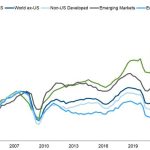Authored by Kenneth Rogoff, op-ed via The Financial Times,
The Fed’s expansive actions to prevent the Silicon Valley Bank collapse from becoming systemic, followed by the Swiss National Bank’s massive lifeline to troubled Credit Suisse, left little doubt this week that financial leaders are determined to act decisively when fear starts to set in. Let us leave moral hazard for another day.
But even if risks of a 2023 financial Armageddon have been contained, not all the differences with 2008 are quite so reassuring.
Back then, inflation was a non-issue and deflation — falling prices — quickly became one. Today, core inflation in the US and Europe is still running hot, and one really has to strain the definition of “transitory” to argue that it is not a problem. Global debt, both public and private, has also skyrocketed. This would not be such an issue if forward looking, long-term real interest rates were to take a deep dive, as they did in the secular stagnation years prior to 2022.
Unfortunately, however, ultra-low borrowing rates are not something that can be counted on this time around.
First and foremost, I would argue that if one looks at long-term historical patterns in real interest rates (as Paul Schmelzing, Barbara Rossi and I have), major shocks — for example, the big drop after the 2008 financial crisis — tend to fade over time. There are also structural reasons: for one thing, global debt (public and private) exploded after 2008, partly as an endogenous response to the low rates, partly as a necessary response to the pandemic. Other factors that are pushing up long-term real rates include the massive costs of the green transition and the coming increase in defence expenditure around the world. The rise of populism will presumably help alleviate inequality, but higher taxes will lower trend growth even as higher spending adds to upwards pressure on rates.
What this means is that even after inflation abates, central banks may need to keep the general level of interest rates higher over the next decade than they did in the last one, just to keep inflation stable.
Another significant difference between now and post-2008 is the far weaker position of China. Beijing’s fiscal stimulus after the financial crisis played a key role in maintaining global demand, particularly for commodities but also for German manufacturing and European luxury goods. Much of it went into real estate and infrastructure, the country’s massive go-to growth sector.
Today, however, after years of building at breakneck speed, China is running into the same kinds of diminishing returns as Japan began to experience in the late 1980s (the famous “bridges to nowhere”) and the former Soviet Union saw in the late 1960s. Combine that with over-centralisation of decision-making, extraordinarily adverse demographics, and creeping deglobalisation, and it becomes clear that China will not be able to play such an outsized role in holding up global growth during the next global recession.
Last, but not least, the 2008 crisis came during a period of relative global peace, which is hardly the case now. The Russian war in Ukraine has been a continuing supply shock that accounts for a significant part of the inflation problem that central banks are now trying to deal with.
Looking back on the past two weeks of banking stress, we should be thankful that this did not happen sooner. With sharply rising central bank rates, and a troubled underlying economic backdrop, it is inevitable that there will be many business casualties and normally emerging market debtors as well. So far, several low-middle income countries have defaulted, but there are likely to be more to come. Surely there will be other problems besides tech, for example the commercial real estate sector in the US, which is hit by rising interest rates even as major city office occupancy remains only about 50 per cent. Of course the financial system, including lightly regulated “shadow banks,” must be housing some of the losses.
Advanced economy governments are not all necessarily immune.
They may have long since “graduated” from sovereign debt crises, but not from partial default through surprise high inflation.
How should the Federal Reserve weigh all these issues in deciding on its rate policy next week?
After the banking tremors, it is certainly not going to forge ahead with a 50 basis point (half a per cent) increase as the European Central Bank did on Thursday, surprising markets. But then the ECB is playing catchup to the Fed.
If nothing else, the optics of once again bailing out the financial sector while tightening the screws on Main Street are not good. Yet, like the ECB, the Fed cannot lightly dismiss persistent core inflation over 5 per cent. Probably, it will opt for a 25 basis point increase if the banking sector seems calm again, but if there are still some jitters it could perfectly well say the direction of travel is still up, but it needs to take a pause.
It is far easier to hold off political pressures in an era where global interest rate and price pressures are pushing downwards. Not anymore. Those days are over and things are going to get harder for the Fed. The trade-offs it faces next week might only be the start.
Loading…











